This conical dish has an inverted rim fluidly hand-painted in an underglaze cobalt blue srcoll motif and a delicately carved chrysanthemum spray enclosed in a double circle in the centre. A thin, finely, crackled yellowish underglaze is visible, partly flaked off on the exterior of the dish. The skills required to carve such designs on the interior of these semi-closed forms is remarkable and the results can sometimes appear as if painted in underglaze brown.The scroll design and the floral spray motif have been painted in low-grade cobalt, giving it blue-brown colour. The decorative schemes of 14th century Chinese blue-and-white of the Yuan (1279-1368) and early Ming period (1368-1644) can be seen in the Vietnamese floral motifs such as the peony, lotus and chrysanthemums, the preferred floral motifs of the Chinese at this time.Technically not ‘porcelain’, which is translucent and pure white, these stonewares are different in appearance from Chinese and other Southeast Asian ceramics. Vietnamese wares are typically more heavily potted and have an off-white clay body. Cobalt oxide could have been imported from West Asia via China to produce the blue tones.The introduction of cobalt-blue into Vietnamese ceramic decoration was deeply influenced by the Chinese who had already mastered the technique by this time. This resulted in the significant development of the Vietnamese ceramic export wares to Islamic countries.Vietnam entered the international trade during the 14th century and produced the greatest volume and variety of wares for Southeast Asia, particularly Indonesia, the Philippines and Malaysia. However, by the 16th century, due to intense competition from the Chinese kilns, the export of Vietnamese wares to these markets was greatly reduced.


















